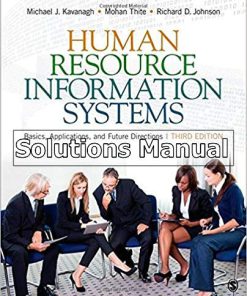-
1 × $26.50
-
1 × $26.50
-
1 × $26.50
-
1 × $26.50
-
Human Sexuality in a World of Diversity Fourth Canadian Canadian 4th Edition Rathus Solutions Manual1 × $26.50
-
1 × $26.50
Human Resource Information Systems 2nd Edition Kavanagh Test Bank
$26.50$50.00 (-47%)
Human Resource Information Systems 2nd Edition Kavanagh Test Bank.
You may also like
Human Resource Information Systems 2nd Edition Kavanagh Test Bank

Product details:
- ISBN-10 : 150635145X
- ISBN-13 : 978-1506351452
- Author: Michael J. Kavanagh
Human Resource Information Systems, edited by Michael J. Kavanagh and Richard D. Johnson, is a one-of-a-kind book that provides a thorough introduction to the field of Human Resource Information Systems (HRIS) and shows how organizations today can leverage HRIS to make better people decisions and manage talent more effectively. Unlike other texts that overwhelm students with technical information and jargon, this revised Fourth Edition offers a balanced approach in dealing with HR issues and IT/IS issues by drawing from experts in both areas. Numerous examples, best practices, discussion questions, and case studies make this the most student-friendly and current text on the market.
Table contents:
PART I: INTRODUCTION TO HRM AND HRIS Chapter 1. Evolution of Human Resource Management and Human Resource Information Systems: The Role of Information Technology Mohan Thite and Michael J. Kavanagh Introduction Historical Evolution of HRM and HRIS Pre-World War II Post-World War (1945?1960) Social Issues Era (1963?1980) Cost-effectiveness Era (1980-early 1990s) Technology Advancement Era and Emergence of Strategic HRM (1990 to Present) Human Resource Activities Interface Between HR and Technology A Primer on Human Resource Information Systems What Is An HRIS? Why Do We Need HRIS? Different Types of HRIS System Development Process for an HRIS A Model of Organizational Functioning Central Themes of the Book Overview and Structure of the Book Chapter 2. Database Concepts and Applications in Human Resource Information Systems Janet H. Marler and Barry Floyd Introduction Data, Information and Knowledge Database Management Systems Early Database Management Systems Relational Database Management Systems Data Sharing Between Different Functions Data Sharing Across Locations Key Relational Database Terminology Entities and Attributes Tables Relationships, Primary Keys, and Foreign Keys Queries Forms Reports Introduction to Microsoft Access Designing a Microsoft Access Database Human Resource Database Application Using Microsoft Access Other HR Databases Data Warehouses, Business Intelligence and Data Mining Chapter 3. Systems Considerations in the Design of an HRIS: Planning for Implementation Michael Bedell, Michael Canniff, and Cheryl Wyrick Introduction HRIS Customers/Users: Data Importance Employees Non-Employees Important Data HRIS Architecture The HRIS ?Dinosaur? 2-Tier Architecture (Client-Server) 3-Tier Architecture N-Tier Architecture Security Best of Breed Recruitment Time Collection Payroll Benefits System Implementation Process Planning Project Manager Steering Committee/Project Charter Implementation Team Project Scope Management Sponsorship Process Mapping Software Implementation Customization Change Management ?Go Live!? Evaluation of Project Potential Pitfalls PART II: DETERMINING HRIS NEEDS Chapter 4. HRIS Needs Analysis Bradley J. Alge and Karen Upright Introduction: HRIS Needs?Planning and Analysis System Development Life Cycle (SDLC) Planning Needs?Long Range Planning Needs: Short-range Planning The Big 3?The Global Positioning System (GPS) of HRIS Analysis for the Big 3 Gap Analysis Chapter 5 System Design and Acquisition Richard D. Johnson and James H. Dulebohn Introduction Design Considerations During Systems Development Life Cycle Logical Design Two Ways to View a HRIS: Data vs. Process Logical Process Modeling with Data Flow Diagrams Physical Design Working With Vendors Vendor Selection Assessing System Feasibility Technical Feasibility Operational Feasibility Legal and Political Feasibility Economic Feasibility Chapter 6. Cost Justifying HRIS Investments Kevin Carlson and Michael J. Kavanagh Introduction Justification Strategies for HRIS Investments Evolution of HRIS Justification Approaches to Investment Analyses Makes a Difference: Some Guidelines HRIS Cost-Benefit Analysis Identifying Sources of Value for Benefits and Costs Estimating the Timing of Benefits and Costs Estimating the Value of Indirect Benefits Estimating Indirect Benefit Magnitude Mapping Indirect Benefits to Revenues and Costs Methods for Estimating the Value of Indirect Benefits Avoiding Common Problems Packaging the Analysis for Decision-Makers PART III: HRIS IMPLEMENTATION Chapter 7. HRIS Project Management Sal Belardo, Peter Otto, and Michael J. Kavanagh Introduction Project Management The Information Technology (IT) Perspective Project Management Literature Project Management Approaches and Tools General IT Factors Affecting Project Management Success The Human Resource Management (HRM) Perspective Identification of the Steering Committee and Project Charter Configuring the Project Management Team Identification of Available Resources and Constraints Controlling Project Creep Selection of Implementation Team Training and Documentation Critical Success Factors Chapter 8. Change Management: Implementation, Integration and Maintenance of the HRIS Romuald A. Stone and Joyce Mason Davis Introduction to the Management of Change What Is Change Management? The Change Management Process: Some Terminology Models of the Change Process ActionResearch Model Lewin?s Change Model Change Equation Formula Nadler?s Congruence Model Kotter?s Process of Leading Change Why Do HRIS System Failures Occur? Leadership Planning Change Management Communication Training Organizational And Individual Issues In HRIS Implementation Cultural Issues Process Reengineering Resistance to Change User Acceptance The Importance of HRIS Integration Practical Approaches to Implementation Post-Implementation and Maintenance of the HRIS PART IV: HRIS APPLICATIONS Chapter 9. Human Resource Administration and HRIS Linda C. Isenhour Introduction to HR Administration in an HRIS Environment HRM Administration and Organizing Approaches Service Oriented Architecture (SOA) and Extensible Markup Language (XML) Advantages of XML-enhanced SOA Theory and HR Administration Self-service Portals and HRIS Advantages of Self-Service Portals for HR Administration Disadvantages of Self-Service Portals for HR Administration Shared Service Centers and HRIS Advantages of Shared Service Centers for Human Resource Administration Disadvantages of Shared Service Centers for Human Resource Managers Outsourcing and HRIS Reasons to Pursue HR Outsourcing (HRO) Disadvantages of HR Outsourcing Offshoring and HRIS Types of HR Offshoring Summary of HR Administration Approaches Legal Compliance and HR Administration HR Administration and Equal Employment Opportunity U. S. Civil Rights Act of 1964, Title VII, and the EEO-1 Report EEO-1 Report (Standard Form 100) EEO-1 and HRIS Occupational Safety and Health Act (OSHA) Record Keeping OSHA Form 300 (Log of Work-related Injuries and Illnesses) and HRIS HR Administration Approaches and Mandated Governmental Reporting Privacy and Security in an HRIS Summary of Government-mandated Reports and Privacy Requirements HR Strategic Goal Achievement and the Balanced Scorecard HRM and the Balanced Scorecard HR Scorecard and Balanced Scorecard Alignment Chapter 10. Talent Management 1: Job Analysis and Human Resource Planning Hazel Williams Talent Management An Inclusive or Exclusive Approach? High Performers and High Potentials Talent Diversity Job Analysis: Keystone of Human Resource Planning Introduction Job Analysis Approaches and Techniques Establishing and Maintaining Accurate Job Descriptions: HRIS Applications A Framework for Strategic Human Resource Planning Analysis and Investigation Forecasting Planning and Resourcing Human Resource Information Systems Utilisation for Talent Management and Human Resource Planning: The Current Status Utilisation of Human Resource Information Systems for Talent Management, Tracking and Human Resource Planning Human Capital Metrics and Analytics Chapter 11. Recruitment and Selection in an Internet Context Kimberly M. Lukaszewski, David N. Dickter, Brian Lyons and Jerard F. Kehoe Introduction to Recruitment and Selection in an Technology Context Recruitment and Technology Recruitment Objectives and Online Recruitment Impact on Recruitment Objectives Quantity, Quality, and Diversity of Applicants Attributes of Recruiting Website Summary of Online Recruitment Selection and Technology What are Selection Tests and Assessments and Why are They Used? Why is Assessment Important for HRIS? Technology Issues in Selection Applying HRIS to Selection and Assessment Demonstrating the HR?s Value with HRIS Selection Applications Summary of Selection Chapter 12. Training and Development: Issues and HRIS Applications Ralf Burbach Introduction Training and Development: Strategic Implications and Learning Organizations Systems Model of Training and Development Training Metrics and Costing/Benefit Analysis HRIS Applications in Training HRIS / Learning Applications?LMS HRIS Training and Development Applications?Implementation Issues Chapter 13. Performance Management, Compensation, Benefits, Payroll and the HRIS Charles H. Fay and Ren Nardoni Introduction to Performance, Rewards and Payroll Performance Management Overview Typical data inputs Typical reports Data outflows Decision support Compensation Overview Typical data inputs Typical reports Data outflows Decision support Benefits Overview Typical data inputs Typical reports Data outflows Decision support Payroll Overview Typical data inputs Typical reports Data outflows Decision support Chapter 14. International Human Resource Management (IHRM) Michael J. Kavanagh and John Michel Introduction: Increasing Importance of International Human Resource Management Types of International Business Operations Differences in HRM in MNEs Managing Different Types of Employees in MNEs Human Resource Programs in Global Organizations International Staffing Selecting Global Managers: Managing Expatriates Training and Development for Expatriates Performance Appraisal in MNEs Managing International Compensation HRIS Applications in IHRM Introduction Organizational Structure For Effectiveness IHRM-HRIS Administrative Issues HRIS Applications MNEs PART V: SPECIAL TOPICS IN HRIS Chapter 15. Information Security and Privacy in an HRIS Yuk Kuen Wong and Mohan Thite Introduction Threats To Information Security Components Of Information Security Confidentiality Integrity Availability Legal Requirements for Information Security Role of HR in Information Security Information Security Management for HRIS Information Privacy Chapter 16. Future Of HRIS: Emerging Trends In HRM and IT Michael J. Kavanagh and Mohan Thite Future Trends in HRM Future Trends in the Field of IT/IS and HRIS Software as a Service (SAAS) Service Oriented Architecture (SOA) Web 2.0 Enterprise Portals Future Trends in Workforce Technologies
People also search:
Human Resource Information Systems 2nd
Human Resource Information Systems 2nd edition
Human Resource Information Systems 2nd pdf
Human Resource Information Systems 2nd pdf free
Human Resource Information Systems 2nd download scribd













































































